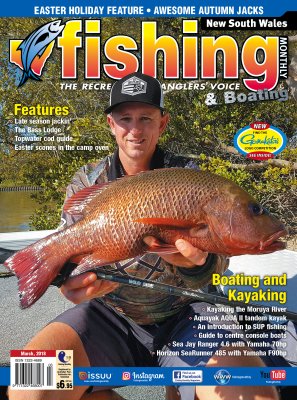Late season jackin’ on the Tweed by Simon Goldsmith
 All too often overlooked by those favoring the Gold Coast, the Tweed River is a mangrove jack fishery that offers much and can deliver plenty for anglers looking for a jack hit.
All too often overlooked by those favoring the Gold Coast, the Tweed River is a mangrove jack fishery that offers much and can deliver plenty for anglers looking for a jack hit.
An easy-to-access open waterway that isn't cluttered with 4 knot speed zones, and easy to get lost in maze-like canals systems like the Gold Coast, the Tweed is a system that you can easily 'run and gun' on when it comes to locating active fish.
One of the Tweed's other great assets is its habitat diversity, with rock bars, rock walls, bridges, timbered banks, and to a lesser degree canals, pontoons and oyster racks offering a host of holding locations for mangrove jack.
The Tweed is a river that offers the best of both worlds when it comes to jack fishing and whether it's natural or man-made structure that you like to target for your fish, the Tweed has it.
THE ARENA
A river that begins with its headwaters deep in the Tweed Valley and within sight of Mount Warning, it's not unil you hit the upper saltwater limit at the weir at Bray Park near Murwillumbah that reliable jack water begins. From here, the river winds it way towards the ocean, passing through and past cane fields, residential areas, townships, rainforest, and mangrove stands.
The Tweed River meets the ocean at Point Danger and in its saltwater reaches is armed by a series of tributaries including the Rous River, Dunbibble Creek, Stotts Channel, Boyds Channel, Bilambil Creek, Cobaki Creek, Terranora Creek, and the Terranora and Cobaki Broadwaters.
All of these locations have the potential of holding mangrove jack, with diversity in habitat type, water flow, temperature, and salinity delivering a host of variables that influence where and when you'll find mangrove jack in residence at the location you're fishing. Research, experience, time on the water, and hopefully some information in this article may help you pinpoint the most productive spots to target.
AUTUMN ACTION
Once we get to the tail end of summer and the early days of autumn, mangrove jack should be in full attack mode, with water temperatures at their highest, bait in abundance, and the metabolism of the fish at its highest during their peak season of activity.
These factors definitely play into the hands of the angler, but this time of the year also potentially offers some challenges, obstacles that you may need to overcome to catch a jack. So lets take a look at the pros and cons of late jack hunting on the Tweed River.
IT'S COMING DOWN
The most northern river in the Northern Rivers region, the Tweed River has a rich history of receiving plenty of rain and its fare share of floods, most of which fall during the late summer and early autumn period. For the jack angler this impact can range from a slight hiccup that's an inconvenience, to writing off the season until next spring rolls around.
The Tweed has two main arms, the main arm that I mentioned that starts up in the Tweed Valley, and the shorter Terranorra arm that joins the main river at Tweed Heads. The shorter arm, being the Terranorra arm, provides a level of protection when the river experiences inflows and a flood, with most of the flow coming down the main river and out to sea, bypassing the Terranorra as it goes.
The outcome often is higher water temperature and salinity levels in the Terranorra than the main arm of the river, two factors that mangrove jacks generally like. Of course, not all rain and inflows are a bad thing, as with a touch of freshwater delivering an increased level of discoloration to the water, this can incite predatory fish to feed more aggressively and actively.
Freshwater inflows can also relocate and increase the movement of bait, and are two changes that can see mangrove jack focus their attention on specific areas and bait types. Prawns are a prime example of species that can be flushed out and congregate in a specific area.
I remember a specific incident when I was fishing a shaded, timber-line mangrove bank one afternoon and in front of me tight against the bank was a mangrove jack feeding with its dorsal fin out the water. It was locked in on the prawns that were abundant along the shoreline, and despite casting a host of different lures at it, none of which spooked the fish or incited a strike, the fish just kept feeding and only had eyes for the prawns in front of it. A prawn imitation lure or fly may have been the ticket to success on the day if I'd had one with me.